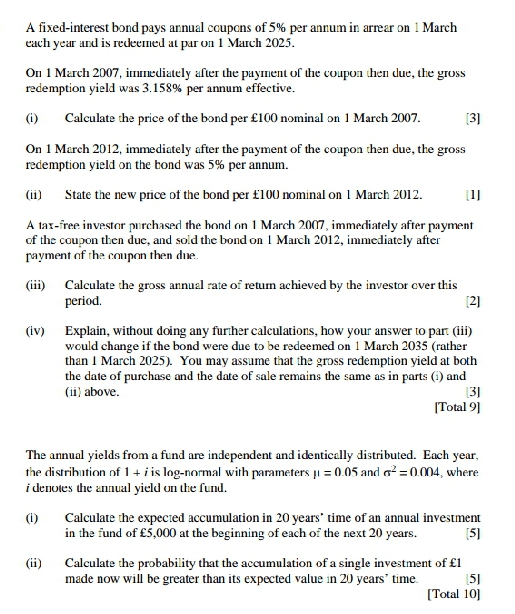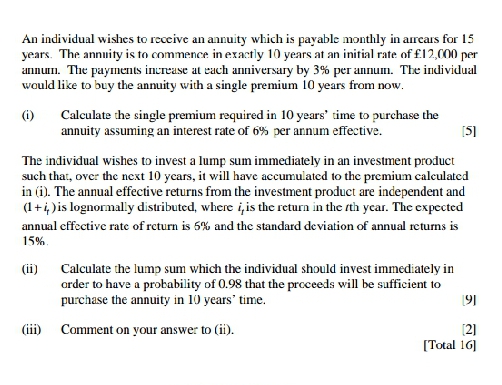

Address the following question effectively. Solve all the parts keenly. Thank you
A fixed-interest bond pays annual coupons of 5% per annum in arrear on 1 March each year and is redeemed at par on 1 March 2025. On 1 March 2007, immediately after the payment of the coupon then due, the gross redemption yield was 3.158% per annum effective. (i) Calculate the price of the bond per f100 nominal on 1 March 2007. [3] On 1 March 2012, immediately after the payment of the coupon then due, the gross redemption yield on the bond was 5% per annum. (ii) State the new price of the bond per f100 nominal on 1 March 2012. (1] A tax-free investor purchased the bond on 1 March 2007, immediately after payment of the coupon then due, and sold the bond on 1 March 2012, immediately after payment of the coupon then due. (iii) Calculate the gross annual rate of return achieved by the investor over this period. [2] (iv) Explain, without doing any further calculations, how your answer to part (lil) would change if the bond were due to be redeemed on 1 March 2035 (rather than I March 2025). You may assume that the gross redemption yield at both the date of purchase and the date of sale remains the same as in parts (i) and (ii) above. 131 [Total 9] The annual yields from a fund are independent and identically distributed. Each year, the distribution of 1 + i is log-normal with parameters p = 0.05 and a-=0.004, where i denotes the annual yield on the fund (1) Calculate the expected accumulation in 20 years* time of an annual investment in the fund of $5,000 at the beginning of each of the next 20 years. [5] (Hi) Calculate the probability that the accumulation of a single investment of fl made now will be greater than its expected value in 20 years' time. 51 [Total 10]An individual wishes to receive an annuity which is payable monthly in arrears for 15 years. The annuity is to commence in exactly 10 years at an initial rate of f.1 2,000 per annum. The payments increase at each anniversary by 3% per annum. The individual would like to buy the annuity with a single premium 10 years from now. (i) Calculate the single premium required in 10 years' time to purchase the annuity assuming an interest rate of 6% per annum effective. [5] The individual wishes to invest a lump sum immediately in an investment product such that, over the next 10 years, it will have accumulated to the premium calculated in (i). The annual effective returns from the investment product are independent and (1 + i, ) is lognormally distributed, where i, is the return in the /th year. The expected annual effective rate of return is 5% and the standard deviation of annual returns is 15% (ii) Calculate the lump sum which the individual should invest immediately in order to have a probability of 0.98 that the proceeds will be sufficient to purchase the annuity in 10 years' time. 191 (iii) Comment on your answer to (ii). [2] [Total 16]










